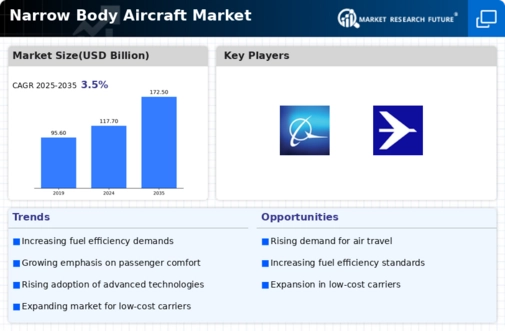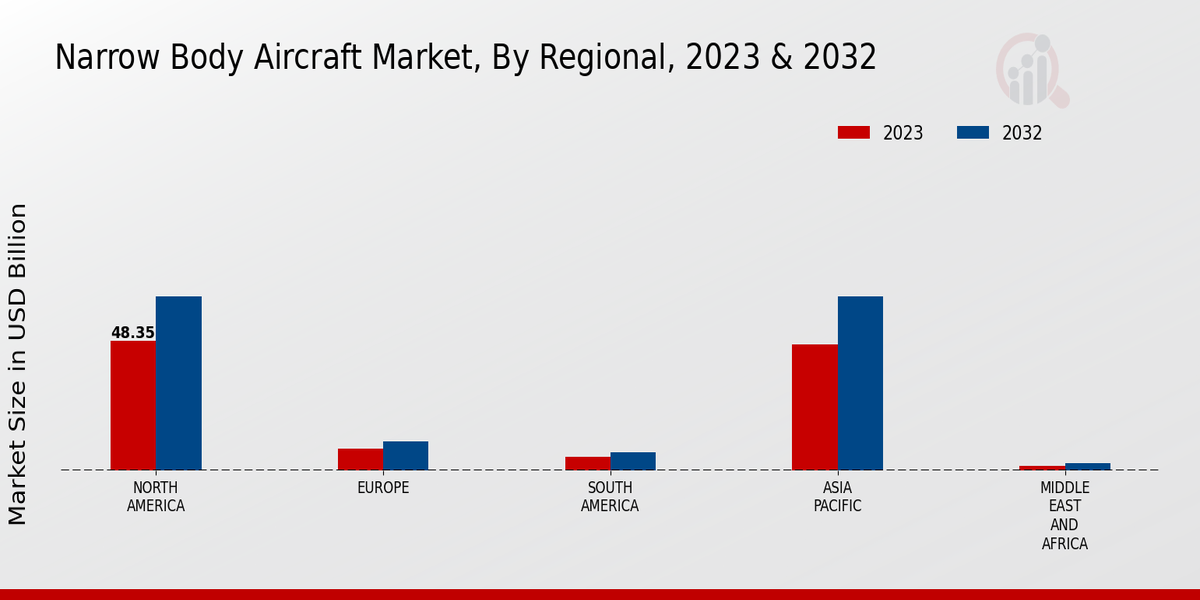Growing Demand for Air Travel
The Global Narrow Body Aircraft Market Industry experiences a surge in demand for air travel, driven by increasing disposable incomes and urbanization. As more individuals seek affordable travel options, airlines are expanding their fleets with narrow body aircraft, which are known for their efficiency and cost-effectiveness. In 2024, the market is valued at 117.7 USD Billion, reflecting the industry's response to this growing demand. Airlines are likely to invest in newer models that offer better fuel efficiency and passenger comfort, further propelling the market's growth. This trend indicates a robust future for narrow body aircraft as they cater to both domestic and international routes.
Expansion of Low-Cost Carriers
The rise of low-cost carriers (LCCs) significantly influences the Global Narrow Body Aircraft Market Industry. These airlines prioritize cost efficiency and accessibility, often utilizing narrow body aircraft for their operations. The competitive pricing strategies employed by LCCs have democratized air travel, leading to increased passenger volumes. As of 2024, the market is projected to grow at a CAGR of 3.53% from 2025 to 2035, largely fueled by the expansion of LCCs in emerging markets. This trend suggests that narrow body aircraft will remain a preferred choice for budget-conscious travelers, thereby solidifying their position in the aviation sector.
Regulatory Support for Aviation Growth
Regulatory frameworks across various regions are increasingly supportive of aviation growth, positively impacting the Global Narrow Body Aircraft Market Industry. Governments are investing in airport infrastructure and streamlining regulations to facilitate air travel. For instance, initiatives aimed at enhancing air traffic management and safety standards contribute to a more efficient aviation ecosystem. Such regulatory support not only encourages airlines to expand their fleets but also fosters competition, ultimately benefiting consumers. As the market evolves, these supportive policies are likely to play a crucial role in sustaining growth and innovation within the narrow body aircraft segment.
Environmental Sustainability Initiatives
The Global Narrow Body Aircraft Market Industry is witnessing a growing emphasis on environmental sustainability. Airlines are under increasing pressure to reduce their carbon footprints, prompting investments in more fuel-efficient narrow body aircraft. The latest models are designed to meet stringent environmental regulations, which are becoming more prevalent globally. This shift towards sustainability is not only a response to regulatory demands but also aligns with consumer preferences for eco-friendly travel options. As the market evolves, the focus on environmental initiatives is expected to drive innovation and investment in narrow body aircraft, ensuring their relevance in a rapidly changing aviation landscape.
Technological Advancements in Aircraft Design
Technological innovations play a pivotal role in shaping the Global Narrow Body Aircraft Market Industry. Manufacturers are increasingly focusing on enhancing fuel efficiency, reducing emissions, and improving passenger experience through advanced aerodynamics and lightweight materials. For instance, the introduction of the latest generation of narrow body aircraft, such as the Boeing 737 MAX and Airbus A320neo, showcases significant improvements in fuel consumption and operational costs. These advancements not only attract airlines looking to optimize their operations but also align with global sustainability goals. As these technologies continue to evolve, they are expected to drive the market's growth trajectory well into the next decade.














Leave a Comment